#Monstrous Compendium Outer Planes Appendix
Explore tagged Tumblr posts
Text

Cambion
Art for Monstrous Compendium Outer Planes Appendix
Artist Unknown
10 notes
·
View notes
Text

The apparition glared at each, its coils twisting, its very appearance shifting and shimmering in the gusty winds of its creation. Both mages held it in check, watching the other intently, waiting for the eye blink, the lip twitch, the spasmodic jerk of a finger that would prove fatal.
"Mages' Battle" by Jeff Easley, from the 1988 AD&D Dragonlance Calendar, inspired by this passage in War of the Twins by Margaret Weis and Tracy Hickman. This also appeared in 1991 as a divider page in AD&D 2e Monstrous Compendium 8: Outer Planes Appendix, and in 1995 as collectible card #82 in Jeff Easley's "Heroes & Villains" series by FPG. It occasionally appears online as "The Battle of Raistlin and Fistandantilus."
#D&D#Dungeons & Dragons#Jeff Easley#Dragonlance#dnd#wizard#mage#Raistlin#Fistandantilus#Raistlin Majere#Krynn#wizards#magic user#demon#demon summoning#magic#magic duel#AD&D#War of the Twins#Margaret Weis and Tracy Hickman#Margaret Weis#Tracy Hickman#Dragonlance Calendar#D&D calendar#1988 Dragonlance Calendar#1980s#TSR
103 notes
·
View notes
Text
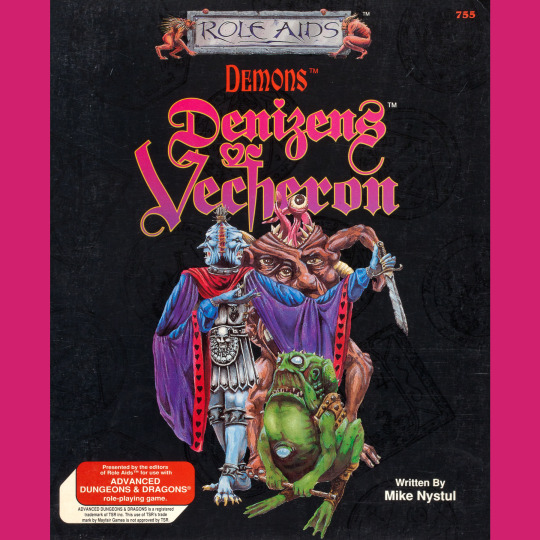
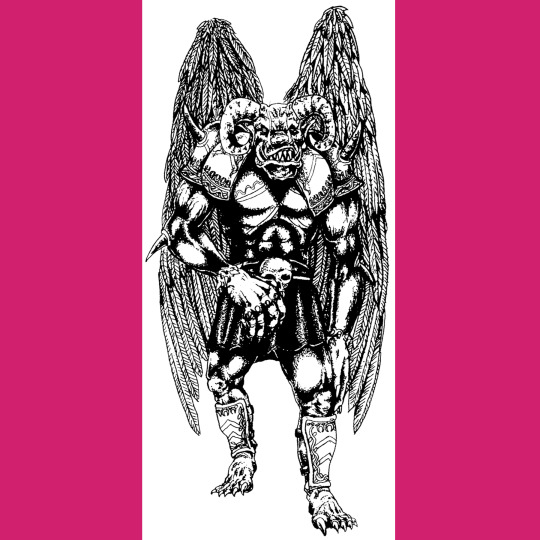
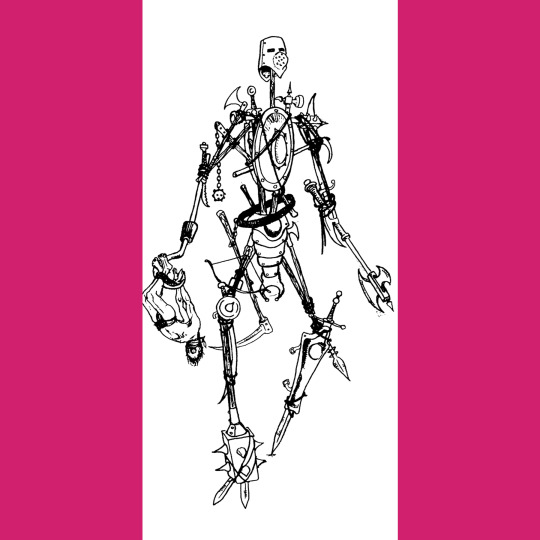
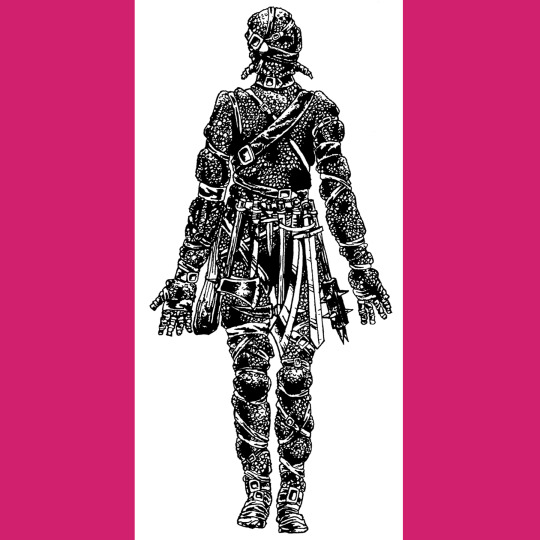
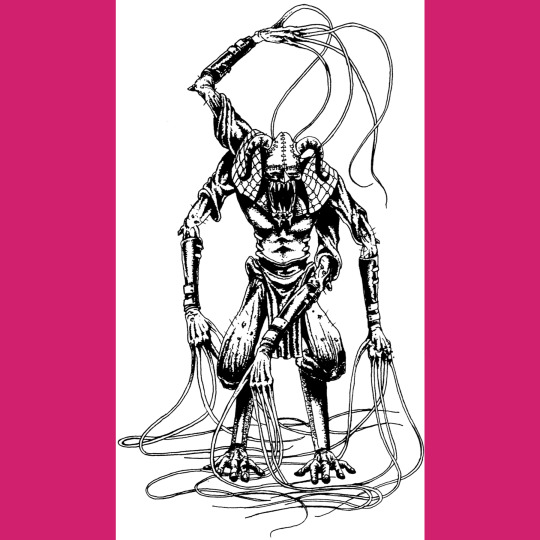
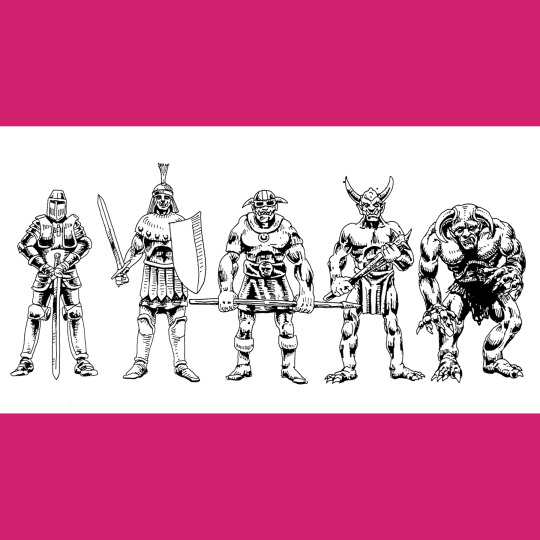
In 1992, Mayfair release the Demons box set as the start of a sub-line of Role Aids. It was followed by Demons II (more demons!), Sentinels (angels!) and Apocalypse (guidance for ending your world in a myriad of ways!). The strong Hellblazer vibes were intentional — Hellblazer cover artist Glenn Fabry did the cover of Demons II. I can’t read this series as anything but directly taunting TSR’s family-friendly positioning of D&D, first by removing them completely, then by sanitizing the demons and devils with silly fantasy names in the Outer Planes Monstrous Compendium Appendix (1991).
Not content with having a run of box sets thumbing their collective noses at TSR, the Demons line also had not one but four monster supplements done in the style of Monstrous Compendium loose leaf sheets (there were already a bunch of these included in the box sets, even, complete with cardstock dividers) issued in similar folders. Honestly, this seems excessive, even to me, a noted lover of the infernal regions.
This is the first, Denizens of Vecheron (1992), by Mike Nystul (who would go on to design the very good The Whispering Vault). I don’t have the title page, so I am not sure who did the art, but it is quite nice and suitably awful. Vecheron is one of six demi-planes that make up the Infernus — it is dominated by an endless sea, and many of the creatures have a slightly nautical flavor. The entries are split between profiles of powerful individuals (the majority, and reminiscent of the Goetia, with a focus on their military ranks and such) and types of monsters. The personalities have a pleasing mix of terrifying attributes and tortured ones, leaving me with the distinct impression that it is no fun being a demon.
#roleplaying game#tabletop rpg#dungeons & dragons#rpg#d&d#ttrpg#Mayfair#Role Aids#Denizens Of Vecheron#Demons
58 notes
·
View notes
Text
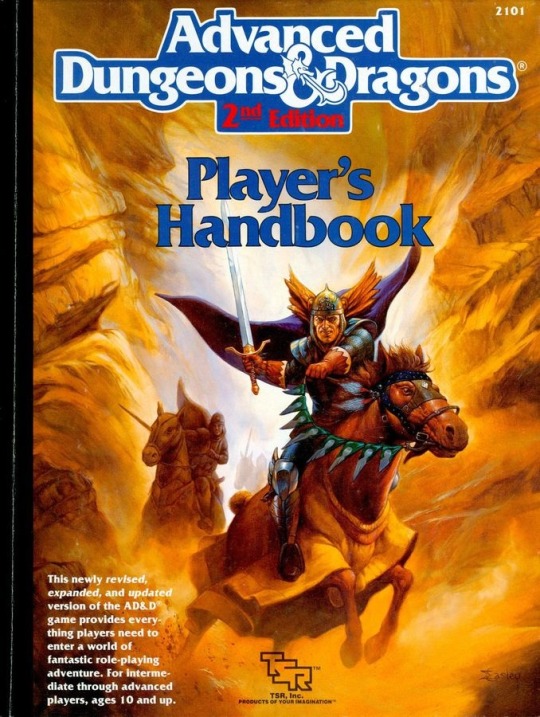
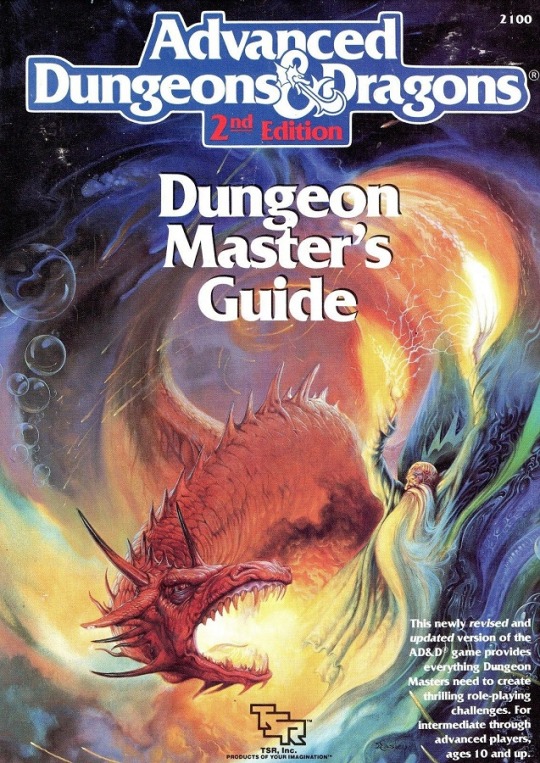
"The second edition of AD&D was finally released in early 1989. Many of the changes turned out to be cosmetic. One of the biggest was that the sizes of the Player’s Handbook (1989) and Dungeon Master’s Guide (1989) were reversed. Back in 1978 Gygax had decided that it was best if the players did not know the rules, and so the original Player’s Handbook was a skeleton that didn’t even detail combat. Now the entire roleplaying industry had accepted the fact that players and gamemasters were united in games — not adversaries — and the new rules reflected this. [...]
Perhaps most surprisingly, the rules were once again presented as “guidelines” — a reversal from Gygax’s original goal for the AD&D lines. Finally, the character classes were indeed cleaned up, with Arneson’s assassin and monk eliminated.
Though Cook had said that assassins were removed due to problems of party unity, their excision has always been seen by the public as part of TSR’s well-documented attempt to make AD&D more public friendly — TSR’s only allowance to the religious hysteria that had shadowed the game throughout the 1980s. Half-orcs were similarly removed as player characters, and demons and devils were eliminated entirely.

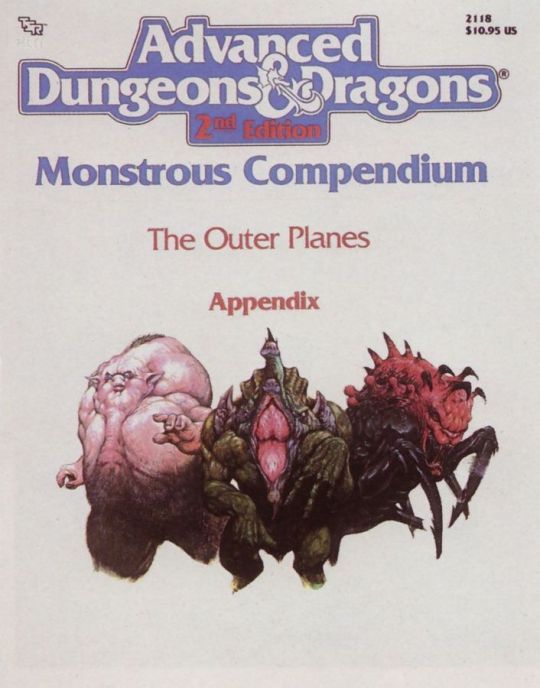
James M. Ward, who had instituted the removal of demons and devils, explained in Dragon #154 (February 1990) that “[a]voiding the Angry Mother Syndrome has become a good, basic guideline for all of the designers and editors at TSR, Inc.” Apparently, TSR had received one letter a week complaining about the demons and devils since the original Monster Manual was printed, and those 624 letters, or what Ward called “a lot of letters,” had been the reason he’d removed the infernal races.
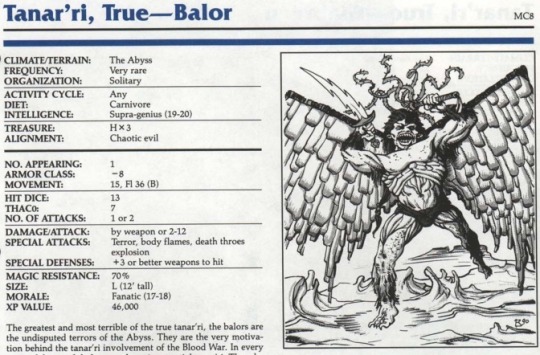
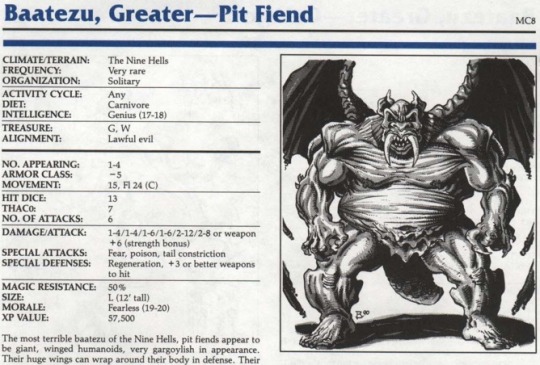
The readers were not amused, and to his credit Ward printed many of their replies in Dragon #158 (June 1990). One reader stated that the decision “becomes censorship when an outside group dictates to you … what you should print.” The release of the Outer Planes Appendix (1991) for the Monstrous Compendium assuaged some of the anger because it restored demons as “tanar’ri” and devils as “baatezu,” but some fans left D&D entirely as a result of this decision."
— Shannon Appelcline, Designers & Dragons: The ’70s
#d&d history#Shannon Appelcline#Designers & Dragons#tsr#gary gygax#ad&d#ad&d 2e#assassin#monk#fiend#David “Zeb” Cook#James M. Ward#information wants to be free
41 notes
·
View notes
Text
Remember how I semi-joked that I felt like I needed to spend three years doing a lit review before I could properly write my Gale Dekarios / Modern Girl in Faerun BG3 fanfic?
My "need to read" list thus far:
Netheril: Empire of Magic (accessory) (1996 / before -339 DR) - Netherese magic
Elminster series: Elminster: The Making of a Mage (novel) (1994 / 212-241 DR) - Elminster personal history
Elminster series: Elminster in Myth Drannor (novel) (1997 / 240-261 DR) - Elminster personal history
Elminster series: The Temptation of Elminster (novel) (1998 / 759-767 DR) - Elminster personal history
"A Question of Balance" in Dungeon magazine 14 (1988 / 1300s DR) - story of Simon Weems being transported from Earth to Faerun
The Knights of Myth Drannor trilogy: Swords of Eveningstar (novel) (2006 / 1348 DR) - Elminster personal history
The Knights of Myth Drannor trilogy: Swords of Dragonfire (novel) (2007 / 1348 DR) - Elminster personal history
The Knights of Myth Drannor trilogy: The Sword Never Sleeps (novel) (2008 / 1348 DR) - Elminster personal history
The Magister (sourcebook) (1988 / 1354-1357 DR) - "written by" Elminster, so Elminster's writing style / voice
Shandril's Saga: Spellfire (novel) (1988 / 1357 DR) - Elminster personal history
Shandril's Saga: Crown of Fire (novel) (1994 / 1357 DR) - Elminster personal history
Old Empires (sourcebook) (1990 / 1357 DR) - general history, history of humans kidnapped from Earth
The Shadow of the Avatar trilogy: Shadows of Doom (novel) (1995 / 1358 DR) - Time of Troubles (led to "death" of Mystra), Elminster personal history
The Shadow of the Avatar trilogy: Cloak of Shadows (novel) (1995 / 1358 DR) - Time of Troubles (led to "death" of Mystra), Elminster personal history
The Shadow of the Avatar trilogy: All Shadows Fled (novel) (1995 / 1358 DR) - Time of Troubles (led to "death" of Mystra)
Hall of Heroes (accessory) (1989 / 1358 DR) - Elminster stats
The Avatar series: Shadowdale (novel) (1989 / 1358 DR) - Time of Troubles (led to "death" of Mystra)
Shadowdale (adventure) (1989 / 1358 DR) - corresponds to novel by same title
The Avatar series: Tantras (novel) (1989 / 1358 DR) - Time of Troubles (led to "death" of Mystra)
Tantras (adventure) (1989 / 1358 DR) - corresponds to novel by same title
The Avatar series: Waterdeep (novel) (1989 / 1358 DR) - Time of Troubles (led to "death" of Mystra)
Waterdeep (adventure) (1989 / 1358 DR) - corresponds to novel by same title
The Grand Tour (comic) (1996 / 1360s DR) - story of adventurers from Earth touring Faerun
Volo's Guide to Waterdeep (accessory) (1993 / 1363-1367 DR) - Waterdeep history
Stormlight (novel) (1996 / 1365 DR) - Elminster personal history
Volo's Guide to the Sword Coast (accessory) (1994 / 1366-1367 DR) - general history
The Avatar series: Prince of Lies (novel) (1993 / 1368 DR) - aftermath of Time of Troubles (led to "death" of Mystra)
City of Splendors (boxed set) (1994 / 1368 DR) - Waterdeep history
Guide to Hell (accessory) (1999 / 1368 DR) - Avernus
A Guide to the Astral Plane (accessory) (1996 / 1368 DR) - githyanki
Baldur's Gate (novel) (1999 / 1368 DR) - novelization of BG1
Baldur's Gate II: Throne of Bhaal (novel) (2001 / 1368 DR) - novelization of BG2
On Hallowed Ground (accessory) (1996 / 1368? DR) - gods of Forgotten Realms setting
Monstrous Compendium: Outer Planes Appendix (accessory) (1991 / 1368? DR) - githyanki
Silverfall: Stories of the Seven Sisters (anthology) (1999 / 1369 DR) - Elminster personal history
Volo's Guide to All Things Magical (accessory) (1996 / 1369 DR) - how magic works in Forgotten Realms setting
Pool of Radiance: Ruins of Myth Drannor (novel) (2001 / 1369 DR) - Elminster personal history
Baldur's Gate II: Shadows of Amn (novel) (2000 / 1369 DR) - novelization of BG2
Faiths & Avatars (accessory) (1996 / 1370 DR) - gods of Forgotten Realms setting
Powers & Pantheons (accessory) (1997 / 1370 DR) - gods of Forgotten Realms setting
Demihuman Deities (accessory) (1998 / 1371 DR) - gods of Forgotten Realms setting
The City of Splendors: A Waterdeep Novel (novel) (2005 / 1370-1371 DR) - Waterdeep history
Sea of Fallen Stars (sourcebook) (1999 / 1371 DR) - Chessentan history
The Avatar series: Crucible: The Trial of Cyric the Mad (novel) (1998 / 1371 DR) - aftermath of Time of Troubles (led to "death" of Mystra)
Forgotten Realms Campaign Setting 3rd edition (accessory) (2001 / 1372 DR) - general history, Chessentan history
Magic of Faerûn (accessory) (2001 / 1372 DR) - how magic works in Forgotten Realms setting
Races of Faerûn (accessory) (2003 / 1372 DR) - general history, history of humans kidnapped from Earth
City of Splendors: Waterdeep (accessory) (2005 / 1372 DR) - Waterdeep history
Lords of Darkness (accessory) (2001 / 1372 DR) - general history
Faiths and Pantheons (accessory) (2002 / 1372 DR) - gods of Forgotten Realms setting
Fiendish Codex I: Hordes of the Abyss (accessory) (2006 / 1372? DR) - infernal contracts?
Fiendish Codex II: Tyrants of the Nine Hells (accessory) (2006 / 1372? DR) - Avernus
Expanded Psionics Handbook (accessory) (2004 / 1372? DR) - githyanki
Elminster series: Elminster In Hell (novel) (2001 / 1372 DR) - Elminster personal history
Elminster series: Elminster's Daughter (novel) (2004 / 1373 DR) - Elminster personal history
Lost Empires of Faerûn (accessory) (2005 / 1374 DR) - Netherese magic, general history
Power of Faerûn (accessory) (2006 / 1374 DR) - general history
The Grand History of the Realms (sourcebook) (2007 / 1385 DR) - general history
The Sundering series: The Companions (novel) (2013 / 1462-1484 DR) - the Second Sundering (led to return of Mystra)
The Sundering series: The Adversary (novel) (2013 / 1478-1486 DR) - the Second Sundering (led to return of Mystra)
Forgotten Realms Campaign Guide (campaign setting) (2008 / 1479 DR) - general history, Chessentan history
"Backdrop: Chessenta" in Dungeon magazine 178 (2010 / 1479 DR) - Chessentan history
The Plane Above (accessory) (2010 / 1479 DR) - githyanki
Elminster series: Elminster Must Die (novel) (2010 / 1479 DR) - Elminster's personal history
Elminster series: Bury Elminster Deep (novel) (2011 / 1479 DR) - Elminster's personal history
Elminster series: Elminster Enraged (novel) (2012 / 1479 DR) - Elminster's personal history
The Rise of Tiamat (adventure) (2014 / 1480s DR) - Waterdeep history
The Sundering series: The Godborn (novel) (2013 / 1450 DR & 1484 DR) - the Second Sundering (led to return of Mystra)
Storm King's Thunder (adventure) (2016 / after 1485 DR) - Waterdeep history
The Reaver (novel) (2014 / 1486 DR) - the Second Sundering (led to return of Mystra)
The Sundering series: The Sentinel (novel) (2014 / 1486 DR) - the Second Sundering (led to return of Mystra)
The Sundering series / Elminster series: The Herald (novel) (2014 / 1487 DR) - the Second Sundering (led to return of Mystra), Elminster's personal history
Elminster series: Spellstorm (novel) (2015 / 1488 DR) - Elminster's personal history
Sword Coast Adventurer's Guide (sourcebook) (2015 / 1489 DR) - current setting guide
Mordenkainen's Tome of Foes (sourcebook) (2018 / 1490? DR) - Zariel & Mephistopheles, githyanki
Death Masks (novel) (2016 / 1491 DR) - Waterdeep history
Baldur's Gate: Descent into Avernus (adventure) (2019 / 1492 DR) - immediately precedes BG3, info on Avernus and infernal contracts
Waterdeep: Dragon Heist (adventure) (2018 / 1492 DR) - immediately follows BG3, Waterdeep current events
Waterdeep: Dungeon of the Mad Mage (adventure) (2018 / 1492 DR) - follows Dragon Heist, Waterdeep current events
Damnit, Gale. All I wanted to do was write smut about my author self-insert fucking a hot wizard but somehow I ended up with homework.
Am I missing anything critical relating to the events of BG3 and permanently solving each companion's major problems?
#it's a lovely morning in faerun and i am a horrible author self insert#the autism won today#forgotten realms#bg3 fanfic writing resources
33 notes
·
View notes
Note
I think we're not looking for pre-1974. We're looking for pre-1978 for the distinction between Lawful Devils and Chaotic Demons, and pre-1991 for the actual conflict between them.
A timeline:
1972: Chainmail has a single-axis Law/Neutral/Chaos alignment (not called "alignment" yet), and no devils or demons.
1974: Dungeon & Dragons: Men & Magic, OD&D's first book, has a single-axis Law/Neutrality/Chaos alignment, and no devils or demons.
1976: OD&D's supplement Eldritch Wizardry has Demons, filed under Chaos. The word "devil" appears here and there, but as a synonym or descriptive, they're not different creatures.
1978: AD&D 1st Edition's Players Handbook introduces the 9 alignments grid, we got Lawful/Chaotic, Good/Evil, Neutral, and combinations. "Law" and "Chaos" now mean something completely different than before.
1978: AD&D 1st Edition's Monster Manual has Lawful Evil Devils and Chaotic Evil Demons. They are now distinct, with different attitudes and organisation, but they're not each other's nemesis or anything.
1991: AD&D 2nd Edition's Monstrous Compendium: Outer Planes Appendix renames Devils to Baatezu and Demons to Tanar'ri (because the christians were complaining, it was the Satanic panic era), files them both under "Fiend", and introduces the Blood War: "For as long as there has been time, these mighty races have clashed with each other in a war of ultimate genocide and wholescale destruction. There can be no compromise in this war. Only total destruction of the enemy will end the Blood War."
I think the Lawful Devils/Chaotic Demons distinction is a direct result of the alignment mechanic as a 2-axis grid. When you had a single axis, from Law to Neutrality to Chaos, representing who's on whose side more than anything (essentially a wargaming rule), it wouldn't occur to you to put devils and hobbits on the same side. (At least normally: by exception, OD&D's Mind Flayers are Lawful "but highly evil". But early D&D books were hardly consistent, or well thought out.) Once you can specify that there's Lawful Evil and Chaotic Evil types, and these are fundamentally different by the very rules of the game, then you can separate fiends to factions.
And I get the impression that the "vs" part, the Blood War, is a direct result of trying to convince Concerned Christians that this has nothing to do with the Bible's Satan, it's another thing altogether, honestly.
So both of these are VERY specific to D&D, and from what I can tell, they don't appear to be inspired by existing fantasy tropes, or mythology and folklore, or anything of the sort.
Because you know a lot about these sorts of things: is D&D the first place where devils and demons are distinct groups of mutually antagonistic evil entities as opposed to being synonyms for one another, or did they steal that from some obscure fantasy pulp novel from the 1960s, as so much other stuff now seen as iconic to D&D is?
Much like making picky distinctions between wizards, sorcerers and warlocks, the general idea of making "devils" and "demons" distinct classes of supernatural beasties pre-dates Dungeons & Dragons in popular fiction, but the specific definitions that D&D uses are basically only applicable to D&D; every work of sword and sorcery fiction I'm aware of that distinguishes between the two terms does so differently.
For example, in Robert Aspirin's "Myth Adventures" series, "Devils" are a specific race of extradimensional aliens who coincidentally resemble pop-Christianity's notion of the Devil (i.e., red skin, goat legs, etc.), while a "demon" is simply any sapient being who's been magically summoned from another dimension. Hence, Devils are sometimes demons (at least when they're away from home), but – unless there's a convention or something going on – the majority of demons in any given dimension are not Devils.
To the point, I can't think of any particular work of pre-1974 (i.e., pre-D&D) sword and sorcery fiction whose demons-versus-devils split hinges on Law and Chaos in the same way that D&D's does; I suspect that the game's authors simply took the pre-existing notion of demons and devils being different things and pasted the terms onto a straight lift of Michael Moorcock's "Eternal Champions" cosmology (which doesn't use either term) – though if anyone is aware of a prior case of fantasy fiction specifically associating "devil" with cosmic Order and "demon" with cosmic Chaos, I'd love to be corrected!
(As always, if anyone would like to offer a counterexample, please check the publication date first; works published after 1974 post-date Dungeons & Dragons, so they're no help here.)
799 notes
·
View notes
Photo
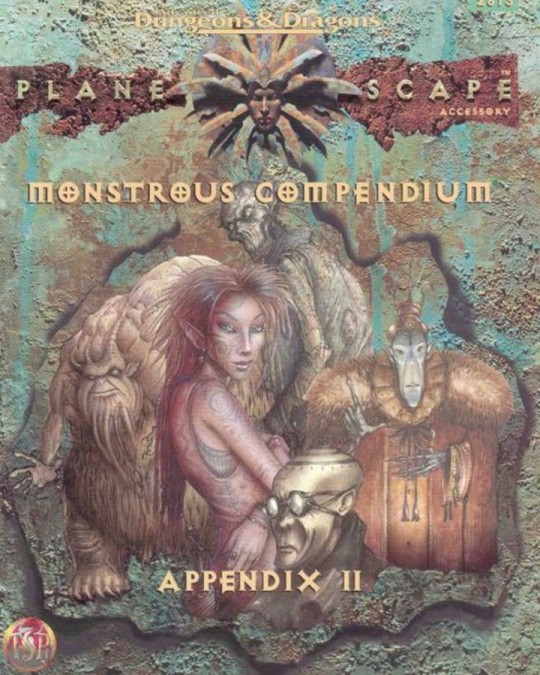
CLUELESS IS AS GOOD AS DEAD. Don't matter if you're a blood's blood or a leatherhead with a lot to learn - this book's for you. The planes are full of critters that'd just as soon kill a berk as look at him, and plenty more that like to rattle their bone-boxes for nothing more than the sheer pleasure of it. What a cutter needs is a book like this one - something that tells the real dark of what's waiting out there, just on the other side of that portal. This MONSTROUS COMPENDIUM appendix contains nearly 100 new monsters from the Outlands and various Outer Planes, and a few updated creatures that haven't seen print for quite some time. The aasimar, a new player character race, awaits your discovery - along with eladrins, hollyphants, rilmani, new tanar'ri, and more! #masterlegendario #planescape #bloodwar #tanari #hell #demons #dnd #dnd5e #vintage #old #oldschool #planeswalker #fiend https://www.instagram.com/p/CV8O5klLWw2/?utm_medium=tumblr
#masterlegendario#planescape#bloodwar#tanari#hell#demons#dnd#dnd5e#vintage#old#oldschool#planeswalker#fiend
0 notes
Photo

Vaporighu, maelephant, bebilith -- denizens of the outer planes (Jeff Easley, MC8, Monstrous Compendium: Outer Planes Appendix, TSR, 1991)
#D&D#Dungeons & Dragons#Jeff Easley#D&D 2e#AD&D#monsters#demon#outer planes#Outer Planes Appendix#Monstrous Compendium 8#AD&D 2e#dnd#Dungeons and Dragons#TSR#vaporighu#maelephant#bebilith
128 notes
·
View notes
Text

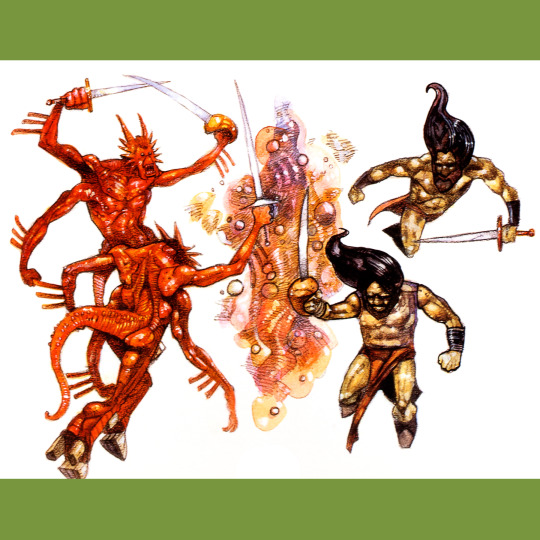


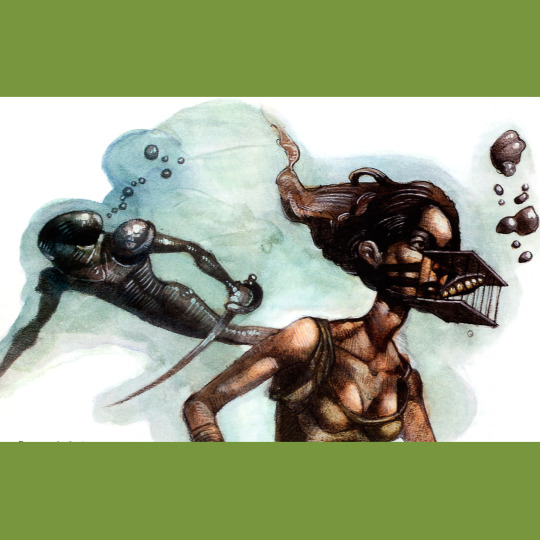
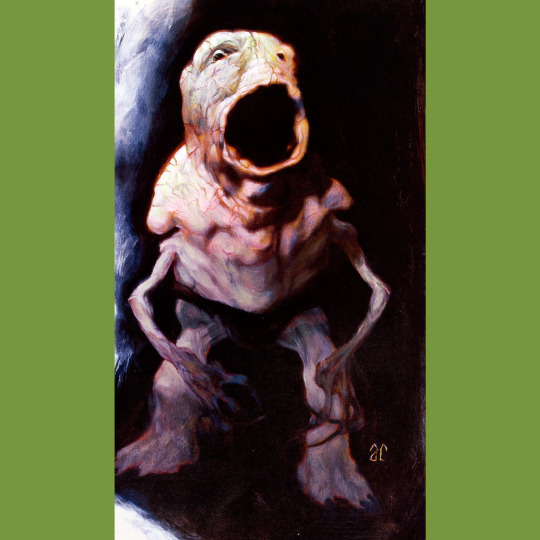

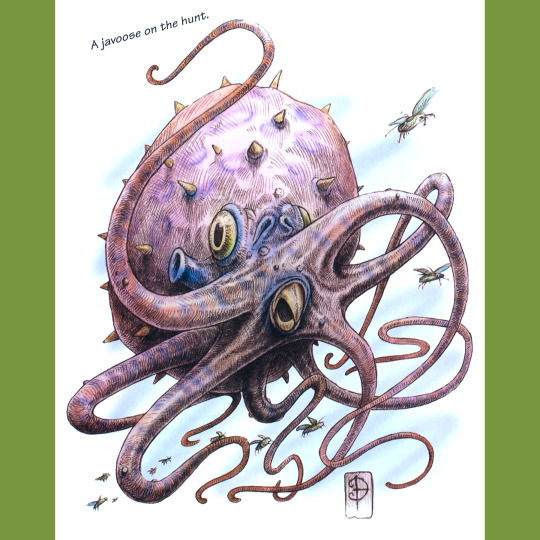

Where the first Planescape Monstrous Compendium is essentially a restatement of the Outer Planes appendix and the second is a wellspring of monstrous adventure seeds, the third (1998) is a bit odd. It functions as a companion book to the Planescape sourcebooks for the Astral, Ethereal and, mostly, the Inner Planes. These are the least comprehensible regions of the multiverse — the Ethereal and Astral are essential the realities between realities, while the Inner Planes are home to all the raw elemental forces that form the building blocks of creation. The monsters in this book largely illustrate how life exists in those seemingly impossible-to-exist-in environments.
With the exception of the Astral, all these places always seems like a hard sell as settings for D&D. The monsters here…are all interesting in the same way something like Barlowe’s Guide to Extraterrestrials is interesting, but they don’t open up avenues of adventure for my brain the way the critters in MCII do. It’s all a little too abstract, a little too illustrative.
Which isn’t to say they aren’t COOL. They are! I just don’t find this book terribly useful. It is especially nice to see Cryonax, the tentacled yeti entity who rules evil cold monsters, in the book, tho. Love that weirdo.
And I think that is the last official Planescape product I had to share. Sad.
140 notes
·
View notes
Text

The Type VI demon (one of whom is named Balor) from the Monster Manual (1977).

The balor, a true tanar’ri, in MC8 Monstrous Compendium Outer Planes Appendix (1991).

The balor in the 3.5 Monster Manual (2003).
The words “tanar’ri” and “baatezu” appeared as early as the Monstrous Compendium Outer Planes Appendix to refer to demons and devils, respectively, because TSR had pledged to remove references to demons and devils with 2E after the Satanic Panic. They also changed the daemons into yugoloths. All of this terminology was maintained throughout the 90s, including the Planescape Monstrous Compendium Appendices and the Monstrous Manual. When Wizards published the Monster Manual in 2000, demons and devils got their names back, while yugoloths stayed yugoloths. The alternate names were referenced in (I believe) the Monsters of Faerun book with the tanar’ruk (demon orcs) and fey’ri (devil elves) detailed there.
The Forgotten Realms wiki usually has 2E entries for monsters. I don’t know why they’re still using tanar’ri and baatezu for 3E and 4E stuff, unless they think it’s a Realms specific set of terms.
So, let's go over everything Wizards of the Coast is trying to do this coming year.
>Erasing everything that made DnD fun
>Sanitizing everything to appease a minority of leftist puritans
>Making anyone who wants to play DnD pay microtransactions
>Making anyone who makes anything based off of DnD pay royalties to Wizards of the Coast
I hope the company fucking crashes and burns, Hasbro failed to claim TSR as their own now we just need it all to crash and burn so TSR can make a big comeback.
10K notes
·
View notes
Photo
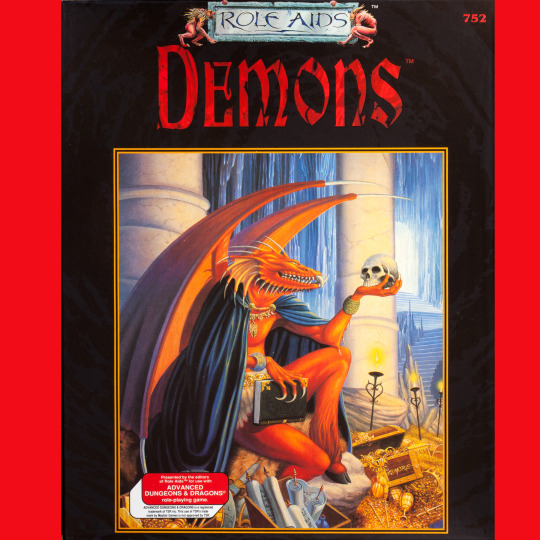
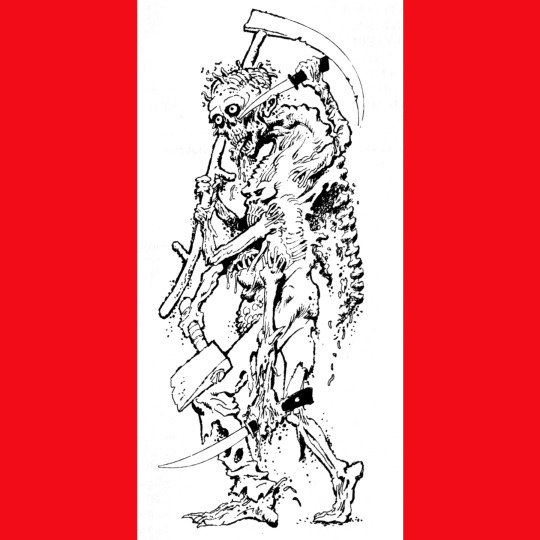



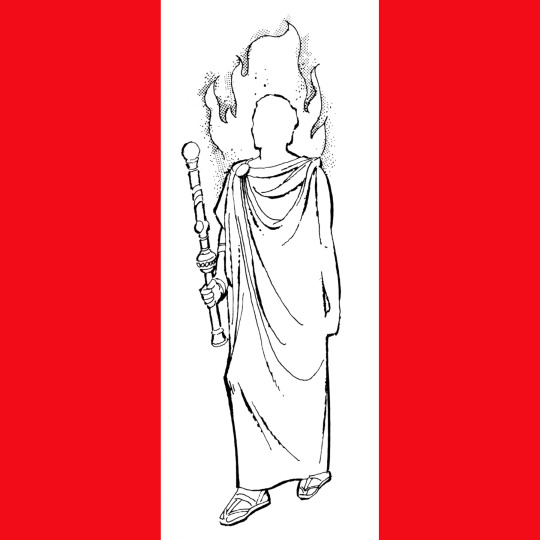
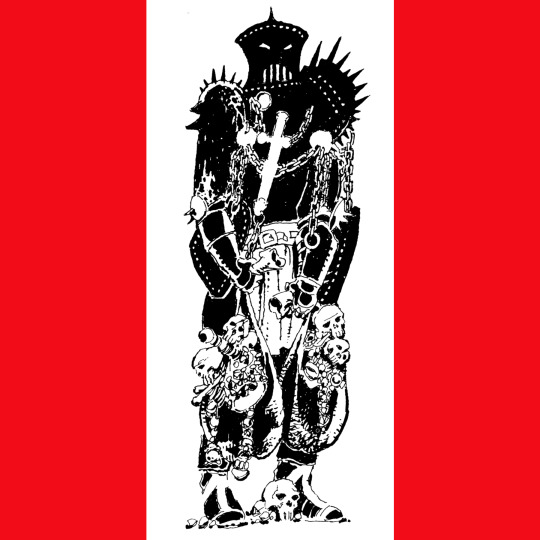
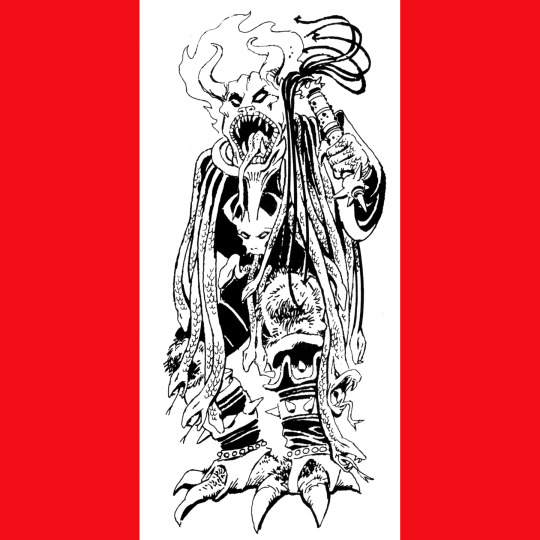
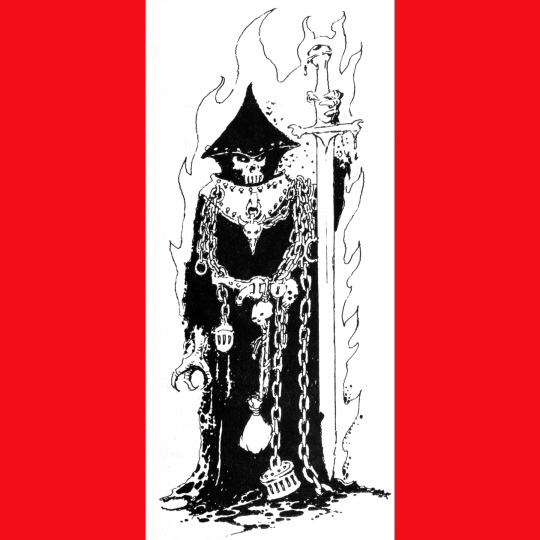
This is the Demons box set (1993), one of many supplements in the unfortunately named Role Aids line from Mayfair Games. Like all the Role Aids material, it was designed to be compatible with Dungeons & Dragons. This was a bit of a problem from TSR’s point of view.
In ‘93, Second Edition D&D was in full swing and it had pissed off a large number of players by removing references to demons, devils and downplaying real world religions, something that was seen by many as a capitulation to the Satanism fearmongers of the 80s. That the Monstrous Compendium: Outer Planes Appendix (1991) re-introduced demons and devils in the Scooby-doo disguise of Tanar’ri and Baatezu made no one happy.
With D&D demonstrably uninterested in the infernal, Mayfair swooped in with the Demons line. Underneath that delicious Larry Elmore cover is a new infernal plane, tons of demons (both rank and file legions and royalty modeled on demons from the Goetia and other real world occult sources), a pile of spells, a new character class and probably some stuff I am forgetting. It all bounces between interesting, slightly disturbing and laughably edge lord-y in equal measure (the interior art is pretty forgettable), but over all, there are some solid ideas here. My favorite thing is the secondary booklet, which is an in-universe tome of demonology, complete with cryptic annotations. Oh, and not only are the monster stats intended to be put in you Monstrous Compendium binder, but Mayfair included a custom divider in the TSR style, which strikes me as particularly cheeky.
This rode a fine line with TSR. The Role Aids line started in 1982 and, though Gygax advocated for Mayfair to receive and official license, the TSR board instead brought Mayfair to court in 1984 for infringing on their trademark. An agreement was reached that allowed the Role Aids line to continue so long as Mayfair limited its use of the D&D trademark (it could appear only once, and had to be small). Mayfair toed the line, mostly, but the two companies were back in court in the early 90s. More on that tomorrow.
#RPG#TTRPG#Tabletop RPG#Roleplaying Game#D&D#dungeons & dragons#Mayfair Games#Role Aids#Demons#Larry Elmore
112 notes
·
View notes
Photo
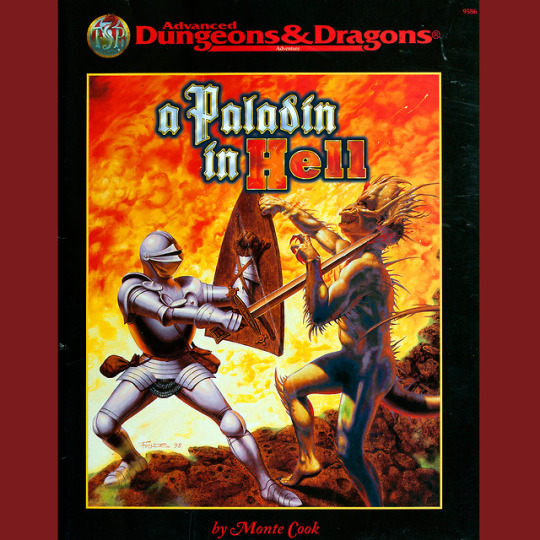






Some history of demons and devils in Dungeons & Dragons. First edition had them, and they freaked some people out, so TSR removed them from 2E (1989). Initially. They were brought back in the Outer Planes Monstrous Compendium Appendix (1991) as Tanar’ri (demons) and Baatezu (devils), with fantasy face-lifts that distanced them from real world religions. Planescape (1994) danced around the issue of the devils, occasionally referring to their realm as Hell and hinting at its dark princes (however, demon lords, few of which had real world equivalents, had already largely snuck back into the game).
Monte Cook’s adventure module A Paladin in Hell (1998) was the first direct attempt to restore something resembling the old version of the fiends to D&D. It is an extrapolation of an iconic Dave Sutherland illustration from the 1E Player’s Handbook (second image). The mod fleshes out the story behind that illustration and sees the players harrow Hell to try to save the paladin (in a ship that is literally part of the Abyss, no less). An adventure for levels 15-20, there’s plenty of devils and demons (Cook dispenses with the silly fantasy names) and other terrors to contend with. Most interestingly, it provides in-game infernal politics to explain the disappearance of some of the devils from 2E.
This scenario is about as heavy metal as D&D gets. Every single one of Arnie Swekel’s interior illustrations looks like a treatment for an album cover for some thrash band. Which is to say: its glorious.
All told, this is an underappreciated classic in the old school mold, filled to brimming with monsters of staggering power. It is also, to my knowledge, the first time the name Asmodeus appeared in print in Second Edition D&D and, as we shall see, Monte Cook didn’t stop there…
Anyone out there friends with Monte? I would love to pick his brain about this module for a larger project on the history of D&D Hell…
Join our Patreon!
#RPG#Tabletop RPG#Roleplaying Game#D&D#dungeons & dragons#A Paladin in Hell#Monte Cook#Arnie Swekel#Asmodeus#David C sutherland III
56 notes
·
View notes
Photo

LISTEN UP, CUTTER... There's lots of bashers that can plant you pretty fast, out here in the planes. And that's the only "pretty" thing about most of 'em. A blood's got to know what's what, or the results won't rise. A lot of creatures out here're just plain bad, and even the good ones can burn you if you rattle your bonebox wrong. What a cutter needs is a guide to what's out there, and if it's twice as big as the previous guide and illustrated in color, that's just a bonus. Sure, there's been other guides to planar creatures, but most're hard to find, don't scan the turf, or just don't have the straight chant.... This MONSTROUS COMPENDIUM appendix includes a broad spectrum of monsters from the Inner, Outer, Astral, and Ethereal Planes - all geared to provide hours of adventure in the PLANESCAPE campaign setting. Replacing the original Outer Planes Appendix, this new and enlarged compendium includes full-color illustrations, reintroducing many of the best mulitplanar monsters from a wide variety of out-of-print sources. #masterlegendario #planescape #bloodwar #tanari #hell #demons #dnd #dnd5e #vintage #old #oldschool #planeswalker #fiend https://www.instagram.com/p/CV2l-n8LfXR/?utm_medium=tumblr
#masterlegendario#planescape#bloodwar#tanari#hell#demons#dnd#dnd5e#vintage#old#oldschool#planeswalker#fiend
1 note
·
View note
Photo




The rest of this week, I’ll be looking at some of the square bound campaign-specific Monstrous Compendiums from 1994-95, the first being the Planescape Appendix.
First things first, the cover is a bit of a disaster. It keeps the Easley trio established in the previous Monstrous Compendium appendices, but plops it rather unceremoniously onto the rusty Planescape background with zero graphic design elegance. Which, whatever. The interior is full of hot new DiTerlizzi art, so all is forgiven.
I love this book. Granted, it is essentially a reprint of the Outer Planes appendix with new art, but that is why it is so important. Where DiTerlizzi’s art in the Planescape box set gave me a new way to see D&D in a broad, general way, his work on this book transformed things I knew and loved into things that were strange and new. This reinterpretation is what finally drove home the idea that D&D could be anything I wanted it to be. That, more than anything else, has sustained my interest in it and other RPGs for decades.
#D&D#AD&D#advanced dungeons & dragons#dungeons & dragons#TSR#RPG#Tabletop RPG#roleplaying game#roleplaying games#Planescape#Tony DiTerlizzi#Monstrous Compendium#Jeff Easley#Outer Planes#Baxa
85 notes
·
View notes